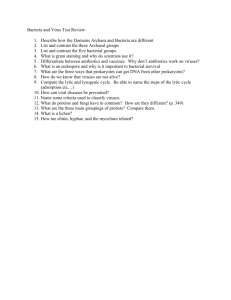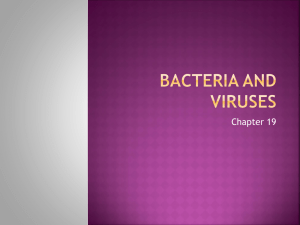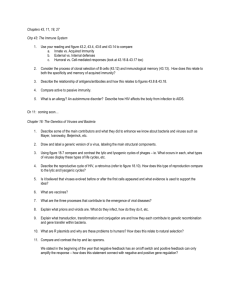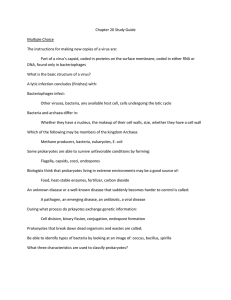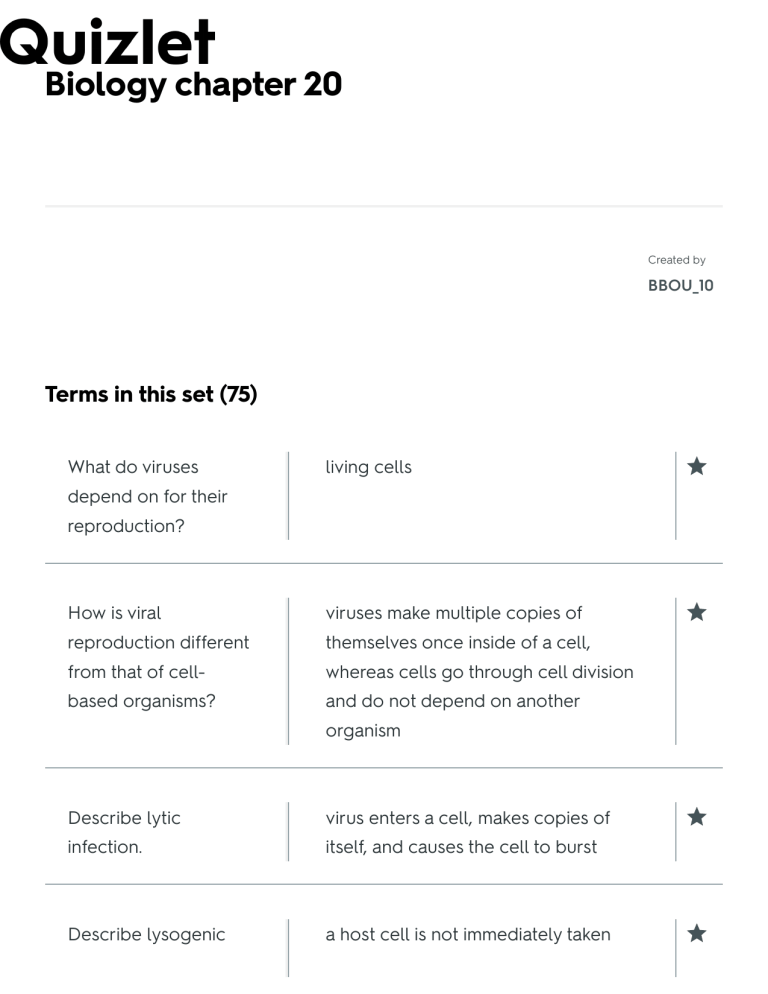
Biology chapter 20 Created by BBOU_10 Terms in this set (75) What do viruses living cells depend on for their reproduction? How is viral viruses make multiple copies of reproduction different themselves once inside of a cell, from that of cell- whereas cells go through cell division based organisms? and do not depend on another organism Describe lytic virus enters a cell, makes copies of infection. itself, and causes the cell to burst Describe lysogenic a host cell is not immediately taken / infection. over, but instead the viral nucleic acid is inserted into the host cell's DNA, where it is copied along with the host DNA without damaging the host How are lytic and both ultimately lead to many infected lysogenic infections cells similar? How are lytic and lytic infections immediately destroy lysogenic infections the host cell, but lysogenic infections different? does not How is the structure A virus is DNA or RNA covered in of a virus different capsid and some with an envelope, from that of a cell? whereas a cell consists of cell organelles, cytoplasm, and a cell membrane Which two domains of Bacteria and Archaea life contain only prokaryotes? Which feature of the the cell walls of bacteria contain cell wall is peptidoglycan characteristic of / bacteria but not archaea? Which category of photoheterotroph prokaryote is the most flexible in the energy sources it can use? List three ecological decomposers, producers, and roles played by consumers prokaryotes Why are nitrogen- they provide 90% of the nitrogen fixing bacteria so used by other organisms important? Why do farmers some plants contain Rhizobium in practice "crop their roots, which converts nitrogen in rotation"? the air into the nitrogen compounds essential for plant growth How do viruses cause bacteria cause diseases by destroying disease? living cells or by releasing chemicals that upset homeostasis / Are vaccines effective before because they prompt the before or after body to produce immunity to a infection? specific disease How does the viral diseases cannot be treated with treatment of viral antibiotics diseases contrast with the treatment of bacterial diseases? Why are emerging they are particularly threatening since diseases of particular humans have little or no resistance to concern? them and no way to control it Why are "superbugs" They are resistant to whole groups of difficult to control? antibiotics What actions can be don't come into contact with others, taken to help combat don't share personal items, cover the evolution of coughs and sneezes "superbugs"? Bacteria and archaea the makeup of their cells walls. differ in / Escherichia coli is a bacterium. classified as Which of the Archaea follow the lytic cycle, while following is NOT a bacteria follow the lysogenic cycle. way in which archaea and bacteria differ? Which of the methane producers following may be members of the kingdom Archaea? Which of the facultative anaerobes following can survive either with oxygen or without it? Some prokaryotes are endospores. able to survive unfavorable conditions by forming What three by shape, how they move, and how characteristics are they get energy / used to classify prokaryotes? Where are you likely near the surfaces of lakes and streams to find a photoautotroph? During an chemoautotrophs. experiment, a scientist observed prokaryotes that lived near volcanic vents deep in the ocean. The scientist most likely observed During what process conjugation do prokaryote exchange genetic information? What would be a Organisms would not be able to get direct consequence the nutrients they need to make of the disappearance proteins. of nitrogen fixing prokaryote? Prokaryotes that decomposers. break down dead / organisms and wastes are called Nitrogen fixation fertilizer. involve each of the following EXCEPT Which of the food for other oragnisms following is NOT produced when prokaryotes break down sewage? Which of the to form a symbiotic relationship and following is NOT a obtain ammonia way in which humans rely on prokaryotes ? Biologists think that heat stable enzymes. prokaryotes living in extreme environments may be a good source of The outer protien capsid. coat of a virus is called a / What 3 materials proteins, nucleic acids, and lipids make up many viruses? Proteins in the viral bind the virus to the surface of a host capsid or on the cell. surface membrane function to The instructions for coded in either RNA or DNA. making new copies of a virus are What is the basic DNA or RNA surrounded by a protein structure of a virus? coat Viruses vary greatly in size and structure. Which of the obtain and use energy following characteristics of living things is NOT true about viruses? A lytic infection concludes with the bursting of the host cell. / A prophage is made viral DNA. of Bacteriophages infect bacteria. Unlike lytic viruses, lyse the host cell right away. lysogenic viruses do NOT During a lytic is destroyed when it bursts. infection, the host cell How do bacteria by destroying cells and releasing cause disease? toxins Bacteria that cause pathogens (germs) disease are called Which of the allowing foods to cool completely following will NOT before refrigerating prevent many bacterial infections? / Which of the AIDS following diseases is NOT caused by a bacterium? An unknown disease an emerging disease. or a well known disease that suddenly becomes harder to control is called Which of the emerging diseases can only be following is NOT a controlled by vaccines. reason emerging disease are especially dangerous to human health? What might people They should use antibiotics only when do to prevent the necessary. development of more superbugs? Scientists think that T archaea may be the ancestors of eukaryotes. If this is true, then archaea / and eukaryotes share a common ancestor that is (more) recent than the common ancestor of archaea and bacteria. Many (archaea) live in T harsh environments, such as hot springs. Prokaryotes are F-membrane-bound organelles different from (nucleus) eukaryotes because prokaryotic cells lack (DNA). Photosynthetic T prokaryotes are important (producers) in ecosystems. Through genetic T engineering, bacteria can be used to synthesize (drugs). / Most viruses can F-specific cell types infect (a wide range of cell types). In a (lysogenic) T infection, host cells can make copies of viral DNA for many generations. Bacteria can cause T disease by releasing (toxins) into the body. (An emerging T disease) is a new disease or a wellknown disease that suddenly becomes hard to control. (An antibiotic) is a F-vaccine preparation of weakened or killed virus or viral proteins. / Like viruses, (prions) T are nonliving and can cause disease. Prokaryotes that carry photoautotrophs out photosynthesis in a manner similar to that of plants are called ___________. The process by which nitrogen fixation prokaryotes change nitrogen gas to a form that plants can use is called _____________. Prokaryotes that decomposers break down dead organisms in an ecosystem are called ________________. Viruses are not reproduce without a host cell considered to be alive because they cannot ________________. / In a lysogenic prophage infection, the viral DNA that is embedded in a host cell's DNA is called a (an) __________. French chemist Louis germ theory of disease Pasteur helped establish the ________________ when he showed that bacteria were responsible for a number of illnesses. West Nile virus, drug - emerging disease resistant tuberculosis, and MRSA are examples of ______________which pose a threat to human health because humans have little resistance to these diseases. An animal that is prions infected by / _______________ will eventually die because so many of these particles accumulate in brain cells that the cells are damaged. Scrapie, an infectious prions disease in sheep, is caused by a (an) _____________________. ________________ can Viruses disrupt cellular homeostasis and can even lead to uncontrolled cell division and the formation of cancers. /
